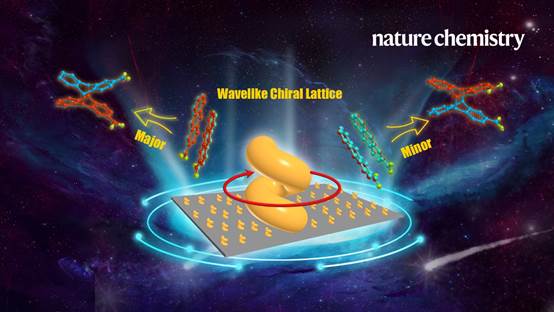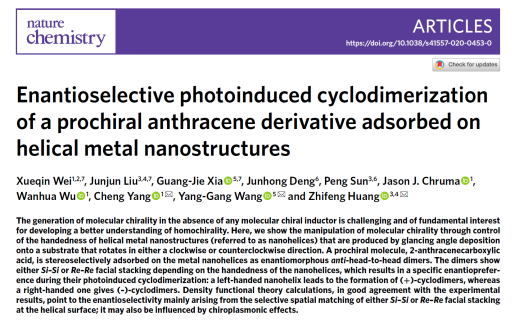Cheng Yang's Team from the College of Chemistry published a paper in Nature Chemistry, proposing a new approach of top-down molecular chirality induction.

In collaboration with Zhifeng Huang’s team of Hong Kong Baptist University (HKBU), andYang-Gang Wang’s team ofSouthern University of Science and Technology (SUSTech),Cheng Yang and team of the SCU College of Chemistry have recently made important progress in asymmetric photochemistry. The research findings are published in a paper entitled “Enantioselective Photoinduced Cyclodimerization of a Prochiral Anthracene Derivative Adsorbed on Helical Metal Nanostructures” inNature Chemistry.

Asymmetric / chiral phenomena exist widely in nature, ranging from cosmic nebulae to microscopic particles. Without the influence of other chiral elements, a pair of chiral molecules (enantiomers) with mutual mirror relationship have the same free energy and equal generation probability.
“Here, we show the manipulation of molecular chirality through control of the handedness of helical metal nanostructures (referred to as nanohelices) that are produced by glancing angle deposition onto a substrate that rotates in either a clockwise or counterclockwise direction. A prochiral molecule, 2-anthracenecarboxylic acid, is stereoselectively adsorbed on the metal nanohelices as enantiomorphous anti-head-to-head dimers. The dimers show either Si–Si or Re–Re facial stacking depending on the handedness of the nanohelices, which results in a specific enantiopreference during their photoinduced cyclodimerization: a left-handed nanohelix leads to the formation of (+)-cyclodimers, whereas a right-handed one gives (–)-cyclodimers. Density functional theory calculations, in good agreement with the experimental results, point to the enantioselectivity mainly arising from the selective spatial matching of either Si–Si or Re–Re facial stacking at the helical surface; it may also be influenced by chiroplasmonic effects.”(Abstract)
This study not only introduces a new top-down strategy for the effective control of molecular chirality, but also provides a new hypothesis for the origin of chirality. Dr.Xueqin Wei of Sichuan University, Dr. Junjun Liu of Hong Kong Baptist University and Dr. Guang-Jie Xia of Southern University of Science and Technology are the first authors of this paper.
Article link:https://www.nature.com/articles/s41557-020-0453-0
